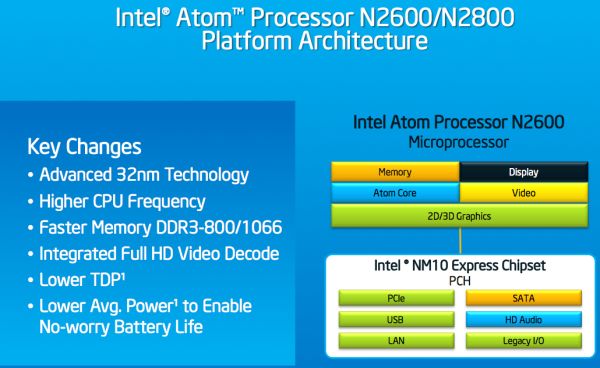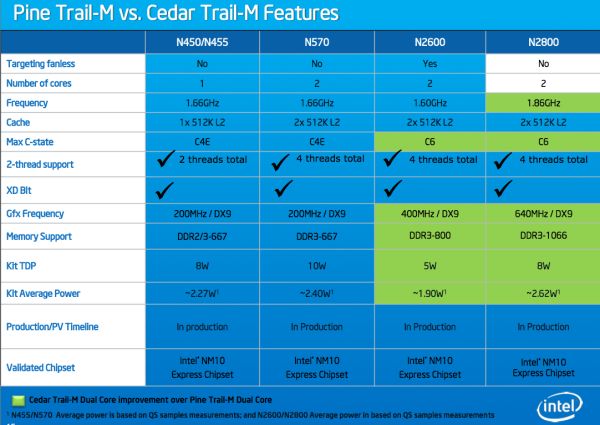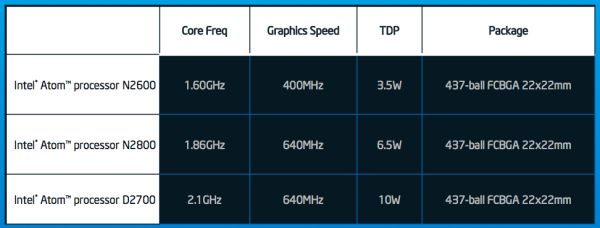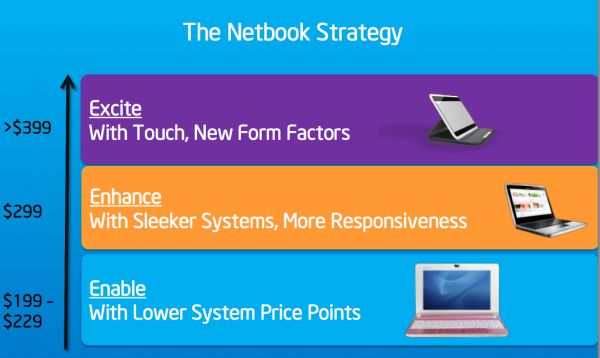Intel's Atom N2600, N2800 & D2700: Cedar Trail, The Heart of the 2012 Netbook
by Anand Lal Shimpi on December 28, 2011 11:00 AM EST- Posted in
- CPUs
- Intel
- Atom
- Cedar Trail
Netbooks aren't dead, but they're not quite the hip topic of discussion they were a few years ago. The focus on cost conscious computing hasn't changed since the introduction of the first netbook, but the maturity of tablets has. Intel still sees the netbook segment as a profitable one (for itself) through 2012, although I'm fully expecting the line between netbook and convertible tablet to blur after the launch of Windows 8.
Atom has been at the heart of nearly all netbooks since the segment's inception. We've seen only one major platform shift since then: from the original 2008 Atom platform to Pine Trail. Pine Trail integrated the GPU and memory controller without significantly changing the Atom architecture. Today Intel is officially announcing its next major netbook platform shift: Cedar Trail.
While the original Atom and Pineview (Pine Trail's Atom) were built on Intel's 45nm process, Cedar Trail moves to 32nm. Cedar Trail's SoC shrinks to 56mm2, finally making it smaller than AMD's Zacate APU. The underlying CPU architecture hasn't really changed, nor have cache sizes (512KB L2 per core) or clock speeds (1.66GHz and 1.86GHz parts available), so what this is really about is a reduction in power consumption.
There are three Atom CPUs being offered as a part of Cedar Trail: the N2600, N2800 and D2700. Just as before, the N-series are for netbooks while the D-series are for desktops. All of the Cedar Trail Atoms are dual-core parts, but they all slot into the same power envelope as the old single-core Pine Trial platforms (5 - 8W). The only exception is the D2700 which is a 10W platform. Note that this is the total TDP for the Atom SoC + the NM10 Express chipset (providing USB, LAN, PCIe, etc...).
The spec breakdown is below:
Given the same number of cores and the same clock speeds, CPU performance shouldn't go up compared to Pine Trail. Since everything is now dual-core we should see a boost at the low end, but I wouldn't expect to see CPU performance that's better than Zacate.
Cedar Trail now supports DDR3-800 and 1066 (up from 667MHz max data rates before). The bigger change is the GPU. The GMA 3150 used in Pine Trail was an Intel Gen graphics derivative (45nm GMA 3100), however Cedar Trail now features a PowerVR SGX 545 sourced from Imagination Technologies. At 640MHz in the N2800, we've never seen the SGX 545 run at anywhere near this clock speed before so it'll be interesting to see how well it performs. Intel is claiming a > 2x GPU performance improvement compared to the GMA 3150 in Pine Trail in 3DMark 06. The big question is Windows driver maturity, but we'll find out soon enough as systems based on Cedar Trail are in production now and are expected to ship in early 2012. Expect to see Cedar Trail netbooks from ASUS, Acer, HP, Lenovo, Samsung and Toshiba for starters.
The new graphics block also includes support for H.264 video decode acceleration (we're still digging for specifics) as well as Intel Wireless Display technology. Note that WiDi support will vary depending on the system and price point:
Intel is expecting the vast majority of Cedar Trail netbooks to be sold in the $199 - $229 price point. At $299 is where you'll likely find features like WiDi as well as potentially fanless designs. Don't expect any of those new form factors at $399 until the later part of next year, likely coinciding with Windows 8's release.
Overall the addition of HD video decode support and lower power consumption are both nice features to have, but I'm skeptical as to whether this will be enough to carry Intel based netbooks throughout the majority of 2012. Atom is in dire need of an architecture update (something we'll get in 2013) and the netbook as a platform is in need of a refresh. I do hope to see some manufacturers taking risks with slim, fanless Cedar Trail based designs next year but we'll have to wait and see if they're any good.














38 Comments
View All Comments
GTVic - Wednesday, December 28, 2011 - link
Yes, that architecture shortcut was mentioned in AnandTech's previous reviews of the original Atom and the Pine Trail version.I'm surprised that this article didn't explicitly state whether there was a change in this area as the previous articles focused on that as a major limitation to the performance.
DanNeely - Wednesday, December 28, 2011 - link
The lack of mention, combined with Intel repeatedly stating the new atom architechture won't launch until 2013 almost certainly means no change. Ripping out on-die FSB would be a major change; intel would've had to commit to doing this a few years ago to create an intermediate part between the current platform and Atom2013. Since Intel was heavily talking up Atom as its gateway to phones initially I suspect the sucess of the netbook/nettop platforms caught them by surprise and it was too late for an intermediate design to be inserted into the lineup.jontech - Wednesday, December 28, 2011 - link
Too bad the iPad hasn't killed off this evil spawnUltrabooks is where its at......
A5 - Wednesday, December 28, 2011 - link
Netbooks cost half as much as even the cheapest iPad and a quarter as much as an Ultrabook. There's probably not much of a market for these in the USA and Europe anymore, but I'm guessing they do pretty well in East Asia, India, and South America.Mygaffer - Thursday, December 29, 2011 - link
Well duh an Ultrabook is much better, you are talking about something at the opposite end of the price spectrum.name99 - Thursday, December 29, 2011 - link
Apple's story for low-end devices is simple --- if you want a cheap MacBook, you buy it on eBay, not from Apple. It's slower and not as pretty --- what do you expect for something cheaper --- but it does the job.I suspect that many Netbook owners would do well to follow the same model. If you're buying a Netbook solely because you want something cheap, you're probably better off buying a year-old laptop from eBay.
blue922 - Monday, January 23, 2012 - link
Not evil, not spawn.Try to shoot 32-128 GB of video on a trip and load that into your iPad. Netbooks still do large storage on the go better than any tablet. That will be true for some time yet. So don't let your biases and lack of creative thinking dis something you have not all the way through about.
MonkeyPaw - Wednesday, December 28, 2011 - link
So when is Intel going to reward us with an out of order low power architecture? So far, all Atom advancements have been rather sad. Since Atom arrived, both ARM and AMD have surpassed it. When is Intel going to bring out the big guns? So far, it looks like a pretty aimless product line with little hope of success. Like Intel graphics, it's another "wait until next time" marketing job.A5 - Wednesday, December 28, 2011 - link
Atom still smokes even the fastest ARM CPUs, and Zacate plays in what is essentially a completely different TDP range. This is just an incremental update enabled by a process shrink - they'll update the architecture when they feel like they need to.frozentundra123456 - Wednesday, December 28, 2011 - link
Can it be the same company that produces this as that produces Sandy Bridge? Unbelievable that they could not make more improvements than this in all these years. I have been looking at getting a tablet, but still would almost prefer a netbook if they came with something besides atom. My ideal would be something like the HP dm1 with the E450, but at a netbook price. Right now, it is running more than 400.00 which seems like a lot for a netbook size device. If something like that could be avaliable for 300.00, that would be awesome.